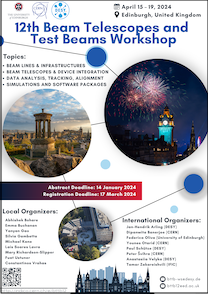Speaker
Description
This work presents significant strides in the fabrication and characterization of LGAD devices, specifically leveraging the innovative AC-Coupled LGAD (AC-LGAD) technology. Building on the expertise gained in controlling the LGAD fabrication process at CNM, our focus has shifted towards highly segmented devices with improved features, including a 100% fill factor and enhanced uniform gain across pixels when compared to standard LGAD architecture, specifically for applications the Medipix family of readout ASICs.
To thoroughly understand and evaluate the inter-pixel response of these devices, a highly collimated monochromatic X-ray beam at Diamond Light Source (B16) with an energy of 15 keV was employed. Comprehensive 2D scans were performed, allowing for an in-depth study of pixel response in relation to beam position and, consequently, the calculation of spatial resolution.
The results reveal a spatial resolution of approximately 10 $\mu$m, a finding consistent with simulations. A simulation model was developed to predict spatial resolution as a function of gain (SNR), providing a valuable tool for anticipating device performance under varying conditions.
This work signifies a comprehensive approach to LGAD technology, encompassing fabrication, characterization utilizing advanced X-ray techniques, and predictive simulation modelling. The achieved spatial resolution, validated by simulation results, underscores the effectiveness of the AC-LGAD technology and its potential impact on high-performance detector applications.
